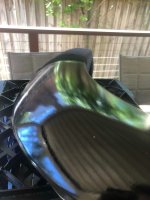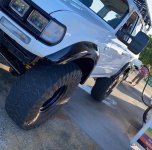Greetings from Australia! This is my first post. I am a novice at painting. I am trying to paint some OEM fibreglass (gel coated) flares I recently got my hands on. I am practicing on a spare flare. I am looking for a super smooth finish but my first attempt did not yield very impressive results. I used rattle cans from the local auto parts shop so perhaps that is my problem, I'm not sure.
My process was as follows:
1. Wash
2. Sand with 80 grit, then with 120 grit
3. Apply wax and grease remover
4. Apply 5 coats of acrylic primer
5. Appy 3 coats of enamel base coat (gloss black) (I am also aware that I used acrylic primer and clearcoat but enamel base. Not sure if this is catastrophic or not)
6. Apply 3 coats of acrylic clearcoat
I am yet to buff and polish the flare as I am waiting for the clearcoat to dry. The finish I got is as pictured:
I am aiming for a finish more like the one pictured here:

What is the cause of my poor finish? What do I need to do to achieve a finish like the one in the second photo?
I understand this may be an open-ended question that is difficult to answer (I have lots of experience of noob questions on forums where I have a much better understanding of the subjects discussed), but as I said I am a complete novice.
Cheers.
My process was as follows:
1. Wash
2. Sand with 80 grit, then with 120 grit
3. Apply wax and grease remover
4. Apply 5 coats of acrylic primer
5. Appy 3 coats of enamel base coat (gloss black) (I am also aware that I used acrylic primer and clearcoat but enamel base. Not sure if this is catastrophic or not)
6. Apply 3 coats of acrylic clearcoat
I am yet to buff and polish the flare as I am waiting for the clearcoat to dry. The finish I got is as pictured:

I am aiming for a finish more like the one pictured here:

What is the cause of my poor finish? What do I need to do to achieve a finish like the one in the second photo?
I understand this may be an open-ended question that is difficult to answer (I have lots of experience of noob questions on forums where I have a much better understanding of the subjects discussed), but as I said I am a complete novice.
Cheers.
